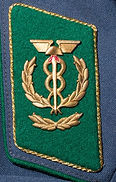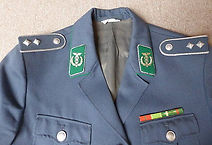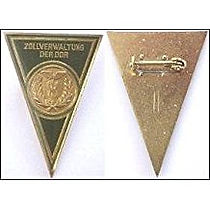


A Focused Effort - A Good Perspective on Collecting
Re-Printed from “Die Nationale Volksarmee –
Journal for the Society of East German Militaria Collectors, # 6, Winter 1994-95
A Focused Effort
by Lou Brown
(If you are a new collector (Even us „Oldsters” can take some advice), then this article from 1994 by Lou Brown is well worth the read and advice over 24 years later.)
Each of us collects East German Militaria for his own reasons. Be it the idea that the uniforms look cool, or a desire to own a part of history, there are reasons why each of us spends good money to buy military items from an army gone defunct. Spending money wisely is the theme of this article, so if you are of independent means, read no further; If, like me, you have to watch what you spend but still want the most "bang for the buck" out of your collection, perhaps some of what follows might be helpful.
There are several stages to collecting. Initially, the recently-addicted collector expends vast sums of money in "impulse buying"; adding everything he can afford and which strikes his fancy to his "collection" until he either runs out of money, room, or both. Having "hit the wall," most folks begin the thought process which eventually leads them to the realization that they have to be judicious. As the fever wears off, a more rational approach to collecting develops, usually a more focused approach which, like a museum display, seeks to make something out of the pile of artifacts. Unfortunately, the collector is generally left with huge stocks of "unwanted items" which don't "fit" anywhere in the newly focused effort -- these represent a burden in both space and dollars which could be used elsewhere. (Some people, by the way, never get to phase two)
To my mind, a collection is not a bunch of artifacts, which is precisely what many folks have. I would argue that there are collectors and there are antiquarians, the latter being someone who acquires items solely because he likes them. Collectors seek to put together items which present something which adds up to more than any of the individual items taken separately. I know an antiquarian who has been in that stage for about forty years; his basement is, literally, a warehouse, but he would be extremely hard-pressed to assemble one truly complete uniform from the mounds of "raw material" he has on hand. He has simply never evolved into a collector. On the other hand, I have a friend who owns exactly eight WWII German artifacts but who has, in my view, a pretty good collection - those artifacts fit together to form an officer's service uniform, complete from cap to boots. He can't afford much (WWII German artifacts are very expensive), but what he has is something representative -- he can say: "This is what an infantry lieutenant in the German army looked like ca. 1939." His collection is extremely efficient. He doesn't own any duplicates, nor does he own anything which does not contribute to what began as his goal when he started--to put together a complete German officer's uniform.
Lest anyone misunderstand, I am not suggesting that only complete uniforms constitute a collection; folks collect all sorts of things, and none are any more legitimate than others. I've known folks who collect only hats, or medals, and build their collecting around variations in manufacture, age, etc., and this strikes me as a viable theme (it's just not the one that appeals to me). I am suggesting that a more rational approach which places the emphasis on proper, prior research and focused buying will, ultimately, lead you past the pitfalls of the early "see it--buy it" stage and let you maximize the use of your money to get the best possible collection you can afford. Toward that end, I offer the following specific comments:
Research
Do your homework; I cannot stress subject matter knowledge enough. If you don't know what things are or how they go together, how can you make anything out of what you collect? Figure out what you want to collect, and then go buy what you need to put it together. When you go shopping or submit mail orders, know what you are looking for and what it looks like (I never go to a store or Militaria show without a "shopping list." This is an excellent way to avoid "impulse purchases.") Don't buy items then try to figure out what they are; that's how you wind up with junk you can't use because it doesn't "fit" with the rest of what you have.
Patience
The codicil to the above -- getting the right stuff entails the virtue of patience. Far too many well-intentioned collectors become overwhelmed with the "vulture syndrome" ("Patience hell, I’m gonna' buy something.") Part of the joy of collecting, however, is in the hunt; finding that specific item you're looking for. It takes time. When my older daughter was two, I realized one of my collecting goals and obtained a German General Staff officer's uniform from WWII; it wasn't until she was fifteen that I completed the uniform by acquiring the right cap, in the right condition, and at the right price. The items you want/need are not going to be hanging neatly in rows at the "NVA Shop: Your one-stop collectors' shopping place!" You are going to have to look for them, and sometimes it will take a long time to get exactly what you want. Have faith; unless your goals are unrealistic (see below), what you want will turn up eventually. (Caution: be sure that when it does, you're not so caught up in finding it that you pay an absurd price to get it or, worse, that you spent the money you needed for it on something else! Nothing hurts worse than seeing someone else walk out of a show with "your" item because you weren't disciplined enough to squirrel away the money so you could buy it when you finally found it.) Like a paleontologist hunting dinosaur artifacts, sometimes you will find whole skeletons; other times a single bone; sometimes, parts of bones; and quite often, nothing. The key is that when the paleontologist doesn't find what he's looking for, he doesn't bring back rocks and change his specialty to geology.
Economy
Be judicious in what you buy. Get the very best quality you can afford for the dollars you have available. (The good news here is that, given the cost of most NVA items, you won't have to content yourself with only eight items.) Consider what you really need before spending any money. If, for example, you have set out to collect "an example of the non-career enlisted service uniform for each component except the Volksmarine," you will need several different jackets, but the trousers are common to all. Unless you are going to dress up in these uniforms with a bunch of your friends (which is sort of strange to begin with), why go out, as some collectors do, and waste money on identical trousers to hang under each jacket? Likewise, one Schuetzenschnur is common to most of those jackets, unless you plan on permanently displaying the uniforms (and I don't mean hanging in the closet), why waste money on several of the same cords? (Of course, if you need the specific one for a special uniform, that’s different). Especially on expensive items, buy the most versatile--the one that will go with the most other things. If you really want an officer's dagger, the LSK/LSK/LV version is, absent other concerns, the best investment since you can use it with "army," "air force," air defense, border troops and civil defense uniforms, - the naval dagger is unique to the VM, and generals' daggers are only for generals. Likewise, except for VM uniforms; older branch-piped items, - and to a lesser extent, generals’ and Fähnrich and LSK officers’ uniforms, there is no difference between a panzer colonel's and a signal lieutenant's uniform -- the rank and branch depend solely upon what shoulder boards you put on it. As such, you would do better to purchase a good array of shoulder straps/boards rather than numerous jackets with "different ranks." Bottom line - you get more for your money in buying the more versatile item, and you have more money to buy more of those versatile items by not tying it up in useless duplication.
Realism
Be realistic in your goals. If you set out to obtain an example of every award the DDR produced, I suspect you will never get there from here - either from cost or availability, you are going to hit some big stone walls which will effectively stop or redirect your efforts. In short, you will have to change your goals. That's not all bad, but why set yourself up for failure from the "git-go?" It is far more satisfying to set achievable goals and expand from them. The goal of having one of every level (I thru III) of every Classification Badge of the 1986 variety is probably achievable. After reaching that goal, or concurrently, you might decide to go back and try the same for the earlier badges. Some looking around will quickly tell you that achieving the same thing with the older badges is, if not improbable simply because of availability, then at least a whole lot harder and a far more expensive proposition; you may have to simply content yourself with a single example of each without regard to level. And that's OK; the two options will "fit" together in your collection, and represent a sensible approach. Likewise, if your sole goal in collecting is to own Heinz Kessler's uniform, you’re going to tire of collecting (or, more accurately, not collecting) very soon. Be sure what you commit yourself to is--at least in some measure - achievable; you might never get there, but that's the challenge.
Philosophy
Only one person needs to be satisfied with your collection - you. If you are comfortable with what you are doing, go for it, and don't let anyone spoil your fun, - I am merely offering another way to think about collecting which might save some folks a few bucks. I learned this the hard way by going through the stages, and I thought some might benefit from that experience (I also have a bunch of stuff I don't need for sale, if anyone is interested…;). The problem in early collecting is that you don't know about the pitfall - it comes as a BGO (Blinding Glimpse of the Obvious); you can't collect everything, so, at some point, you’re going to have to make some decisions. That is done better early than late. Also, don’t be too intense about all this--it's to enjoy (and yes, I do occasionally buy items for no reason other than that they look neat and I like them. Banana splits are only bad as a regular diet.)
Many dealers (Remember, this article was written in 1994 – ed) are selling items as they came to them, hilling them as a "panzer colonel's uniform," etc. (mostly in good faith, though you may bet that some are making up uniforms). Unfortunately, the fact that a uniform came out of Europe "set up" in a certain way probably means very little. Folks keep telling me that, for the cost involved, no one in their right mind would have expended the effort to take off old shoulder straps/boards and put new ones on. While that might be true for dealers and importers, no one knows for sure what was done with the uniforms before they were bought and shipped to the US. The assumption that the importers bought them direct from the DDR government and sold them to US dealers is just that--an assumption. I was stationed in Germany in '90-'91, and when the wall went down but before Reunification, the folks in the East were selling anything/everything they could lay hands on to make money, and people were paying more for "higher ranking" uniforms. Lots of the uniforms which were later bought up and exported lay around for months on barracks floors where they were picked over by tourists, souvenir hunters, and kids looking for toys. An acquaintance of mine bought the complete, full wall locker of a Grenztruppe from the custodian of the barracks who was supposed to be there to protect the government property through transition. In the West, I saw more than a few uniforms which were incorrectly made up in those days (officer insignia on a wooly uniform, e.g.), and I know the NVA didn't do that. Interestingly, as more became known, the "gross" uniforms quickly disappeared and began to appear with the correct stuff on them. The conclusion I reached was that the West Germans were assembling the uniforms from pieces, often based on very poor knowledge. While no one really knows the whole truth, it is my opinion that unless you know for sure that the piece you are going to purchase came from a specific person, if the difference between, for example, a major's blouse and a lieutenant's is more than the cost of the individual shoulder boards, you are probably wasting your money. The jacket you're buying might have been worn by an NVA regimental commander, but might just as well have been made up from stock pieces by a little old lady from Dresden looking to make a few Deutschmark, or an enterprising West German who was willing to spend the two minutes needed to change the insignia to get $50 more per jacket.
Quick Tip - Displaying your Collection
Re-Printed from “Die Nationale Volksarmee –
Journal for the Society of East German Militaria Collectors, # 6, Winter 1994-95
QUICK TIP
by Lou Brown
Collectors amass piles of small artifacts like badges, insignia of rank, awards, etc. By and large, these "little items" wind up in bags or boxes or hidden away in drawers, waiting for their opportunity to be put onto a uniform and displayed. Sadly, for many, this day never comes, - either because they are unpopular, or not as attractive as their friends, these lonely relics are destined to spend the rest of your life in darkness. With a little imagination and effort, however, you can change all this and make a lot of artifacts happy in the process, as well as adding classy decor to your "war room."
Cardboard is a good way to get your smaller items out into the light in an attractive way. Get a piece of sturdy cardboard about the size of a picture frame and cover it. Textured contact paper makes a nice effect, but I've found that fabric offers some interesting alternatives. Since you don't need much, look in the remnants bin at any fabric store; for a dollar or two, you can pick up scraps of classy-looking satins or even velvet. Choose colors which will set off the items you plan to display. Attach some sort of hangar on the back - a piece of colored twist cord - available for a few cents in fabric stores - stapled in place to the top rear corners makes a nice hangar. Next attach your items - in some sort of appealing layout - to the cardboard. Items which don't have pins can be attached via straight pins, a shoulder strap, for example, can be hung on a single straight pin passed through its buttonhole.
More sophisticated effects can be obtained by first covering the cardboard with foam rubber; you can buy it in various thicknesses (I've found the backing from carpeting is excellent). Simply glue it to your cardboard before covering. For a truly professional but inexpensive display, mount your cardboard in a picture frame (actual shadow boxes are way too expensive), with or without the glass in place (deep frames work best, but simply covering the cardboard provided with the frame works well for displaying thin items). One collector I met displayed his officer's dagger in a deep frame. He laid the dagger and hangar on a piece of foam rubber, traced their outline, and then cut out the shapes with an Xacto knife. After gluing the foam to the cardboard, he covered it with red satin, and laid the dagger and hangar in the recesses before setting them in the frame. He can enjoy his dagger in a classy display anytime without having to dig it out of some drawer; yet, because he used the sort of frame held together by snaps, it is still easily accessible.
The only limitation is your imagination, but for very little you can get a lot of items out into the light of day. And remember, as the old collector who gave me the idea said: "Jemand hat Pappe." ("Everyone has cardboard.")






